RBSE Solutions for Class 7 Maths Chapter 15 Comparison of Quantities In Text Exercise is part of RBSE Solutions for Class 7 Maths. Here we have given Rajasthan Board RBSE Class 7 Maths Chapter 15 Comparison of Quantities In Text Exercise.
| Board | RBSE |
| Textbook | SIERT, Rajasthan |
| Class | Class 7 |
| Subject | Maths |
| Chapter | Chapter 15 |
| Chapter Name | Comparison of Quantities |
| Exercise | In Text Exercise |
| Number of Questions | 16 |
| Category | RBSE Solutions |
Rajasthan Board RBSE Class 7 Maths Chapter 15 Comparison of Quantities In Text Exercise
Do and Learn
(Page 159)
Question 1
Find the ratio of actual length and breadth (RBSESolutions.com) of mathematics book of class VII.
Solution:
Length of book = 27 cm.
Breadth = 15 cm
![]()
![]()
Question 2
Find the ratio of length and breadth of national flag by taking help from your teacher.
Solution:
Different size of national flag (RBSESolutions.com) length and breadth ratio as follows :
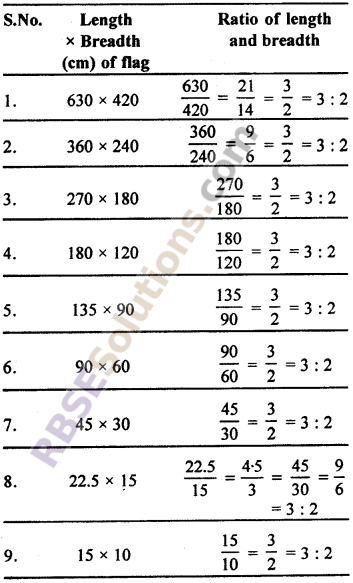
Question 3
Find the ratio of length and breadth (RBSESolutions.com) of your classroom by measuring it
Solution:
Let the length and breadth of room is 30 feet and 20 feet.
Ratio = 30 : 20 = \(\frac { 30 }{ 20 }\) = \(\frac { 3 }{ 2 }\) = 3 : 2
Question 4
Measure your height and measure the length by expanding both the hand completely. Now find out the ratio between these two quantities.
Solution:
Length of both hands = 60 cm
Self height = 120 cm
Ratio = 120 : 60
\(\frac { 120 }{ 60 }\) = \(\frac { 2 }{ 1 }\) = 2 : 1
(Page 162)
Question 1
25 students of class tell their (RBSESolutions.com) interests about games.
Kabbadi – 4 students
Cricket – 11 students
Chess – 6 students
Tennis – 3 students
Other games – 1 students
Express the number of students in percentage according to the interest in each game.
Solution:
Total students = 25
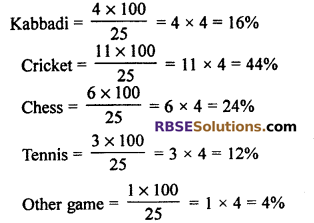
Question 2
Following results are obtained on taking (RBSESolutions.com) advice of 250 students of preference of menu of mid day meal is selected school of Jalore Panchayat.

Express the percentage of preference of each type of menu from the above results.
Solution:
Total number (RBSESolutions.com) of students = 250
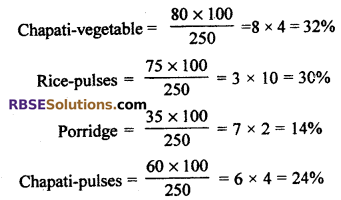
![]()
(Page 163)
Question 1
Convert the following (RBSESolutions.com) fractions into per-centage.
(i) \(\frac { 5 }{ 8 }\)
(ii) \(\frac { 5 }{ 3 }\)
Solution:

Question 2
Convert the decimal(RBSESolutions.com) fractions into percentage.
(i) 0.5
(ii) 0.08
(iii) 0.225
(iv) 6.5
Solution:
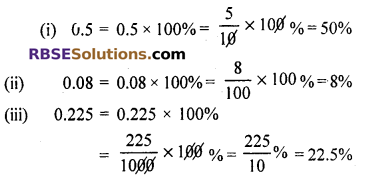
![]()
Question 3
Convert the percentage (RBSESolutions.com) into simple fraction and decimal fraction
(i) 36%
(ii) 12\(\frac { 1 }{ 2 }\)%
(iii) 3.6%
Solution:
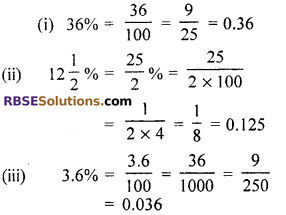
(Page 166)
Question 1
The population of a village is increased (RBSESolutions.com) to 15000 from 12000 in last 10 years. Then what is the percentage growth of population ?
Solution:
Population of village = 12000
Increased population of village in last 10 year = 15000
Increase in population = (15000 – 12000) = 3000
![]()
Question 2
Express rate of growth or loss in the (RBSESolutions.com) form of percentage in the following :
(1) The cost of electricity per unit has increased to ₹6.00 from ₹3.50
(2) The cost of 100 envelopes has decreased to ₹80 from ₹100.
Solution:
(1) Original rate per unit = ₹3.50
Increased rate per unit = ₹6
increase = 6 – 3.50 = ₹2.50
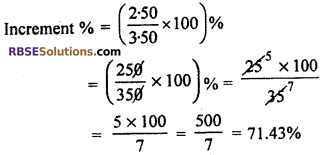
(2)100 envelopes cost = ₹100
New price = ₹80
Decrease in price = 100 – 80 = ₹20
Decrease % = \(\frac { 20 }{ 100 }\) x 100% = 20%
![]()
(Page 168)
Question 1
Mahaveer bought 5 bags of sugar for ₹16000. He (RBSESolutions.com) spent ₹200 for taxi fare, ₹120 for labour charges and ₹200 for transporttation charges. Find the selling price of per kg of sugar so as to earn a profit of ₹3 on each kg.
Solution:
Cost of 5 bags of sugar = ₹16000
Other expenses = ₹200 + ₹120 + ₹200
= ₹520
∴ Total C.P. of 5 bags of sugar
= ₹16000 + ₹520 = ₹16520
∵ Profit on 1 kg = ₹3
Profit on 5 bags or 500 kg sugar
= 500 x 3 = ₹1500
So, Profit = S.P – C.P
or S.P = C.P + Profit
= 16520+ 1500 = ₹18020
So, S.P. of 5 bags = ₹18020
S.P. of 1 bag = \(\frac { 1820 }{ 5 }\) = ₹3604
Question 2
Manoj bought a second hand car for ₹1,50,000. He spent ₹60,000 on Its (RBSESolutions.com) engine repair and ₹15000 on replacing the tyre tubes. Manoj sold this car to Jitendra for ₹2,10,000 Calculate loss or gain in this business.
Solution:
Cost of car = ₹1,50,000
Expense on engine = ₹60,000
Expense on tyre & tube = ₹15,000
Total cost price = ₹2,25,000
Selling price = ₹2,10,000
Manoj has a loss
So, Loss = C.P – S.P
= 2,25,000 – 2,10,000
Loss = ₹15,000
Manoj has a loss of ₹ 15,000
(Page 170)
Ashok has borrowed ₹50000/- for the construction (RBSESolutions.com) of his house. This borrowed amount is known as Principal. He repays ₹55000 to that institute after one year.
Ashok paid ₹5,000/- extra on ₹50,000. This extra amount is known as interest.
The amount of interest depends on following things:
1. Borrowed money (Principal)
2. Time (Period for which the amount is borrowed).
3. Rate (The extra amount paid on per hundred) which is determined on the basis of per mounth/per annum.
You can find the amount you have to pay at the end of the year by adding sum borrowed and the interest
i.e., Amount = Principal + Interest
Question 1
How much interest would Ashok have pay after 2 years if he (RBSESolutions.com) was not able to return the money to the instutute after 1 year ?
Solution:
Because after one year he pays ₹5000/-
as interest so in 2 years he has to pay ₹10000/- as interest.
Question 2
How much money in (RBSESolutions.com) total has to be paid including interest?
Solution:
Amount = Principal + Interest
= 50,000 + 10,000
= ₹60,000/-
![]()
We hope the RBSE Solutions for Class 7 Maths Chapter 15 Comparison of Quantities In Text Exercise will help you. If you have any query regarding Rajasthan Board RBSE Class 7 Maths Chapter 15 Comparison of Quantities In Text Exercise, drop a comment below and we will get back to you at the earliest.